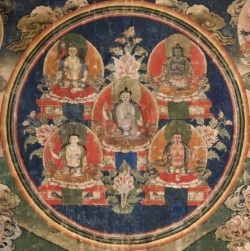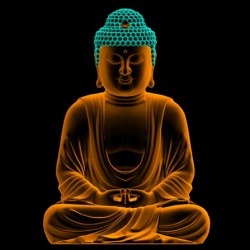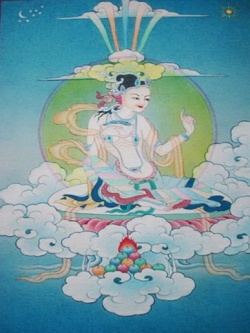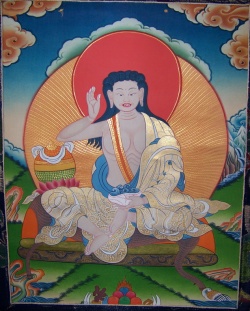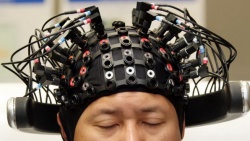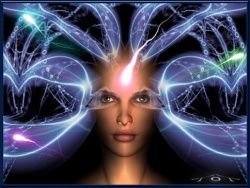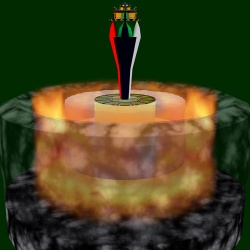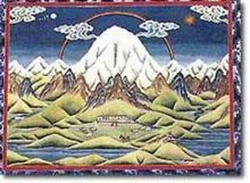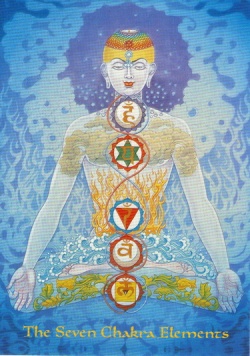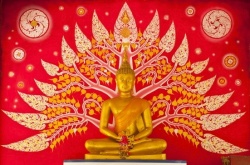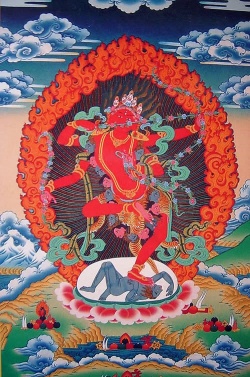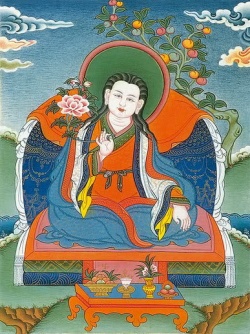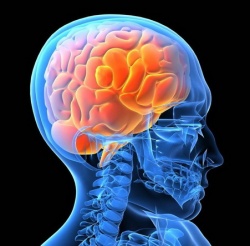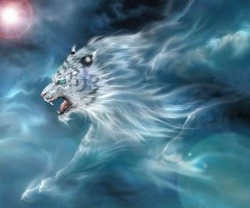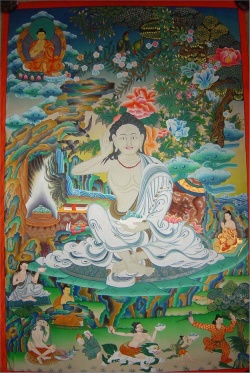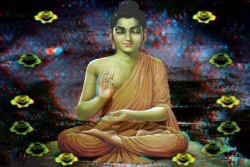Buddha's Logic
Theodor Ippolitovich Stcherbatsky (1866-1942) was a Russian scholar of Oriental Studies, and specifically a world renown (during his lifetime) specialist of Buddhist studies. To him is attributed:
"Having analysed the whole of Buddhist literature
we shall set up such a philology as will surpass,
as a younger one, classical (Graeco-Roman) philology,
and raise India higher than Greece and Rome,
to which she has a full right."
He journeyed, and his scholarly work and its publications saw Stcherbatsky regarded by many scholars in the west and in the east, as the leading figure in world Buddhology. He made a detailed study of the emergence of Buddhist thought in India, and specifically a detailed analysis of Vasubandu's Abhidharmokosha. He wrote:
"the concept of dharma is the central point of Buddhist doctrine,
in which it admittedly occupies the keystone position".
The following article is from the book Buddhist Logic, a two volume English translation of 1930-32, reissued 1970.
The article is entitled:
Indo-European symposium
on the reality
of the external world
and Buddhist logic
Monism </poem> First conversation - Subject Monism
1-st Vedantin ... Real at the beginning was the Nought.[1]
2-nd Vedantin ... Real at the beginning was neither Existence nor the Nought.[2]
3-rd Vedantin ... Real at the beginning was only Existence, the One-without-a-Second.[3] It was Brahman.
4-th Vedantin ... The Brahman is identical with our own Self. The «This» art «Thou![4]»
Parmenides ... There is no Nought.[5] The Universe is the One. It is immovable.
Democritus ... Immovable is the Nought. It is Empty Space. It is filled by moving atoms.[6] </poem> The Buddhist ... There is an Empty Space. It contains an infinity of perishable Elements. There is a Nought (Nirvana), when all the perishable Elements have perished.
Nagarjuna ... All perishable objects are relative and void. Their Nought, or the Great Void,[7] is the only reality. It is the Buddha (in his Cosmical Body).
Spinoza ... There is only One Substance! It is God (in his Cosmical Body).
Dignaga ... The Culmination of Wisdom is Monism[8]. This Unity is the Buddha (in his Spiritual Body).
Dharmaklrti ... The essence of Consciousness is undivided![9] Subject and object is an illusive division. Their unity is Buddha's Omniscience, his Spiritual Body!
Yogacara Buddhist ... With the only exception of Buddha's knowledge which is free from the division in subject and object, all other knowledge is illusive, since it is constructed as subject and object.[10]
Second conversation. Subject Dualism and Pluralism
Sankhya ... There is not one eternal principle, but there are two: Spirit and Matter. Both are eternal, but the first is eternal stability, the other is eternal change. There is no interaction at all possible between them. However the change of the one is somehow reflected, or illumined, in the immovable light of the other. Inside Matter itself, six receptive faculties and six respective kinds of objective Matter are evolved. There is thus a double externality; the one is of the Matter regarding the Spirit. The other is of one kind of matter regarding the other. There is no God!
Descartes ... All right! There are only two substances, the one extended, the other conscious. But both are eternally changing. There is a God, which is the originator and the controller of their concerted motion!
The Buddhist (Hinayana) ... There is neither a God, nor an Ego, nor any spiritual, nor materialistic enduring substance. There are only Elements (dharmas), instantaneously flashing and disappearing. And there is a law of Dependent Origination in accord with which the Elements combine in aggregates. Just as in the Sankya there are six receptive faculties and six corresponding objective domains. There is thus here also a double externality. The one is of all Elements regarding one another, the other is of the six objective domains regarding the six receptive faculties.
Sankhya ... These Elements are infra-atomic units (gunas), they are unconscious and eternally changing.
Heracleitus ... These Elements are flashes appearing and disappearing in accord with a Law of continual change.
Democritus ... These Elements are Atoms (material).
Herbart ... These Elements are Reals (immaterial).
Mach ... These Elements are nothing but sensations. Both the Ego and Matter are pure mythology. When philosophy is no more interested in the reality of an Ego, nothing remains but the causal laws of Functional Interdependence of sensations, in order to explain the connection of the whole.
J. St. Mill ... The so-called Substance is nothing but a permanent possibility of sensations. "The notions of Matter and Mind, considered as substances, have been generated in us by the mere order of our sensations». Phenomena are held together not by a substance, but by an eternal law (of Dependent Origination).
Nagarjuna ... Dependent Origination is alone without beginning, without an end and without change. It is the Absolute. It is Nirvana, the world sub specie aeternitatis.[11]
Logic of naive Realism and critical Logic
Third Conversation. Subject - the Logic of naive Realism and critical Logic
Dignaga ... However the Universe sub specie aeternitatis can be cognized only by mystic intuition.[12] It cannot be established by logic!
Candrakirti ... It can be established by the condemnation of logic![13] Since all logical concepts are relative and unreal, there must be another, non-relative, absolute reality, which is the Great Void. It is the Cosmical Body of the Buddha.
Dignaga ... In logic «we are only giving a scientific description of what happens in common life in regard to the sources of our knowledge and their respective objects.[14] We do not consider their transcendental reality!» In logic we can admit the reality of the external world.
Candrakirti ... What is the use of that logic,[15] if it does not lead to the cognition of the Absolute?
Dignaga ... The Realists are bunglers in logic. They have given wrong definitions. We only correct them![16]
The Realist ... The external world is cognized by us in its genuine reality. Just as the objects situated in the vicinity of a lamp are illuminated by it, just so are the objects of the external world illuminated by the pure light of consciousness. There are no images and no Introspection. Self-consciousness is inferential.[17]
The Yogacara Buddhist ... There are images and there is introspection. «If we were not conscious of perceiving the patch of blue colour, never would we perceive it. The world would remain blind, it would perceive nothing». There are therefore no external objects at all. Why should we make the objective side of knowledge double?
Realist ... But the running change[18] of our perceptions can be produced only by the Force of Experience. They change in accord with the change in the external world![19]
Buddhist ... You need to assume some sort of Biotic Force in order to explain the change. It will be either the Force of Experience,[20] or the Force of Productive Imagination,[21] or the Force of Illusion.[22] If you assume the latter there will be no reality at all in the phantom of an external world. If you assume the first there will be a superfluous double reality. If you assume the second you will have a transcendental ideality along with phenomenal reality.[23]
The Bealist ... Your theory resembles «a purchase without paying!»[24] Indeed the external world, although consisting of mere point-instants, receives coloured perceptibility through imagination, but it can offer nothing in exchange, since it consists of colorless points! If sensation and understanding are entirely heterogeneous, how can a pure sensation be comprehended under a pure concept of the understanding, «as no one is likely to say that causality, for instance, could be seen through the senses?"[25]
Kant ... There must be some third thing homogeneous on the one side with the category and on the other with the object as it is given in concrete.
Dharmakirti ... The intermediate thing is a kind of intelligible sensation. We assume that after the first moment of pure sensation there is a moment of intelligible sensation by the inner sense which is the thing intermediate between pure sensation and the abstract concept.[26] There is moreover between them a Conformity or Coordination.[27]
The Realist ... What is this Conformity or Coordination?
Vasubandhu ... It is the fact owing to which cognition, although also caused by the senses, is said to cognize the object and not the senses.[28] The object is the predominant among the causes of cognition.
Dharmakirti ... Coordination or Conformity is "Similarity between things absolutely dissimilar ».[29] Indeed all things as unities are things in themselves, absolutely dissimilar from other things. But in the measure in which we overlook their absolute dissimilarity (their «in themselves»), they become similar. They become similar through a common negation. That is why all images are Universals and all Universals are mutual negations. Negativity is the essence of our Understanding. The senses alone are affirmation.[30]
Hegel ... According to my Dialectical Method, Negativity is equally the essence of the objective world, which is identical with the subjective one.
Dharmakirti ... We must have an Affirmation contrasting with the Negativity of concepts.
Herbart ... [[Pure [sensation]] alone is Affirmation, it is absolute position!
Dignaga ... Our logic aims at being equally acceptable to those who deny the existence of the external world and to those who maintain it. No one can deny that there are two kinds of cognized essences - the Particular and the Universal. The particular seemingly always resides in the external world, the universal is always in our head.
Berkley ... There are no real universal or abstract ideas.
Dignaga ... There are no particular ideas at all, an idea is always abstract and general. A particular image is a contradictio in adjecto. Particulars exist only in the external world. In our Mind apart from pure sensation, we have only universals.
Berkley ... However to exist means to be perceived, esse est percepi. The external world does not exist beside what is perceived.
Dignaga ... To exist means to be efficient.
Kant ... It is "scandalous" that modern philosophy has not yet succeeded to prove beyond doubt the reality of the external world! If there were no things in themselves the phenomena as they appear to us would become such things. The things are «given» to our senses, they are "cognized", i.e., constructed, by the Understanding in accord with its categories.
Santiraksita ... Yes! Pure sensation is of course non-constructive, but it is a point-instant (Kraftpunkt) which stimulates the understanding to produce its own (general) image of the thing.
Dharmottara ... Is it not a great miracle! The senses represent the Thing brightly, vividly, but they understand nothing definite. The intellect understands definitely, but without vividness, vaguely, dimly, generally; it can construct only a Universal. However the miracle is easily explained, The Understanding is Imagination!
the Thing-in-Itself
Fourth Conversation. Subject - the Thing-in-Itself
F. H. Jacobi (and others) ... Supposing the Things-in-Themselves really exist, they cannot affect our sensibility; since Causality, being a subjective Category, is possible only between phenomena,[31] not between things.
The Jaina ... Yes indeed! A thing which is strictly in itself, which has absolutely nothing in common with all other things in the whole world, is a non-entity, a flower in the sky! If you wish to distinguish it from a non-entity you must admit «Thingness" as a real Category, just as Causality and Substantiality.[32]
Dharmottara ... Thingness, Causality, Substantiality are of course general Categories of the Understanding. They are general and dialectical. But the single pure sensation is neither general, nor is it imagined, nor is it dialectical.
There is a limit to generality, that out of which generality consists. Causality is not itself a sensible fact,[33] it is an interpretation of it. But the Thing-in-Itself is a cause, a reality, an efficient point-instant, a dynamical reality, a unity, a thing as it is strictly in itself, not as it is in the «other», or in the «opposite". The terms ultimate particular, ultimate cause, ultimate reality, the real thing, the real unit, the thing in itself, the thing having neither extension nor duration are synonyms.
But it does not follow that Causality, Reality, Thingness, Unity, etc., are not general terms, different categories under which the same thing can be brought according to the point of view. There is no other genuine direct reality than the instantaneous Thing-in-Itself. Its cognition alone is pure Affirmation, it is not dialectical, not negative, it is direct and positive.
Thus the fact that Causality and Reality are concepts and Categories for the Understanding, does not in the least interfere with the fact that the Thing-in-Itself is the reality cognized in pure sensation.
Hegel ... Your Thing-in-Itself is a phantom![34] It is Void.[35] It is an "absolute beyond» to all cognition.[36] Cognition becomes then contradictory, it becomes a cognition of a reality which is never cognized.[37]
Demokritus ... [38] The Thing-in-Itself far from being a phantom is nothing but the material Atom, underlying the whole of phenomenal reality.
Epikurus ... The Thing-in-Itself (arche) is the material Atom together with the Vacuum and Motion.
Lucretius ... We must admit a principium or semen, and it is the material solid Atom.
Hegel ... This principium is neither the Atom, nor an «absolute beyond», but it is included in the idea of cognition. It is true that the very idea of cognition requires the object as existing by itself, but since the concept of cognition cannot be realized without its object, therefore the object is not beyond cognition.
"Inasmuch as cognition becomes sure of itself, it is also sure of the insignificance of its opposition to the object".[39] Thus it is that the Thing-in-Itself as something beyond cognition, and opposed to it, disappears and the subject and object of cognition coalesce, according to the general rule that everything definite is not a thing «in itself", but a thing «in its other» or «in its opposite!"
Dharmottara ... It is true that the thing becomes definite only when it is a thing related to, or included in, the other. But when it becomes definite it pari passu becomes general and vague. Vivid and bright is only the concrete particular, the Thing as it is in itself.
Dharmakirti ... First of all, it is not true that the Thing-in-Itself means cognition of something that never is cognized. And then it is also wrong that the relation of the object to its cognition is one of inclusion or identity. Indeed, if the Thing-in-Itself would mean something absolutely incognizable, we never would have had any inkling of its existence.
It is not cognized by our Understanding, it is not -understood", but it is cognized by the senses in a pure sensation. It is cognized brightly, vividly, immediately, directly. Its cognition is instantaneus.We call it «unutterable». But again it is not unutterable absolutely.
We call it «the thing», the «in itself», the cause, the point-instant (svalaksana), efficiency, pure object, pure existence, reality, ultimate reality, pure affirmation, etc. etc. Understanding, on the other hand, means indirect cognition, judgment, inference, imagination, analysis, generality, vagueness, negativity, dialectic. Productive Imagination can imagine only the general and dialectical. But the senses cognize the real and the real is the particular.
Dharmottara ... The relation of the object to the subject of cognition in logic is not Identity. The object is not included in the subject. It is wrong to reduce all relations to «otherness» and then to declare that the opposites are identical. The relation of cognition to its object is causal.[40] Object and cognition are two facts causally interrelated.
Fifth Conversation. Subject - Dialectic
Hegel ... The relation between subject and object, between internal and external, seems at first to be causal, as between two realities.[41] But regarding them as an organic whole, there is no causal relation inside them at all.[42]
There is nothing in the effect which did not preexist in the cause[43] and there is nothing real in the cause except its change into the effect.[44] But notwithstanding their identity cause and effect are contradictory. A change or a movement is possible only inasmuch as the thing includes a contradiction in itself.[45] Motion is the reality of contradiction.[46]
Kamalasila ... We must distinguish between Causality and Contradiction. Causality is real, Contradiction is logical. Simple humanity, whose faculty of vision is obscured by the gloom of ignorance, indeed identifies causality with contradiction.[47] But philosophers must know the difference between contradiction and simple otherness, between otherness and necessary interdependence, between Causation and Coinherence, or Identity. They must know the theory of Relations of our Master Dharmakirti.
E. v. Hartmann (to Hegel) ... Your Dialectical Method is simple madness![48]
Dharmakirti (to Hegel) ... Your Dialectical Method is quite all right; but merely in the domain of the Understanding, i.e. of constructed concepts! Concepts are interrelated dialectically. Reality is interrelated by the causal laws of Dependent Origination. There is moreover an Ultimate Reality where subject and object coalesce. There is thus an imagined reality (parikalpita), an interdependent reality (paratantra) and an ultimate one (parinispanna).
Conclusion
In the course of our analysis we have quoted parallelisms and similarities, partial and complete, from a variety of systems and many thinkers of different times. But it would not be right to conclude that the Indian system is a patchwork of detached pieces which can be now and then found singly to remember some very well known ideas. The contrary is perhaps the truth.
There is perhaps no other system whose parts so perfectly fit into one compact general scheme, reducible to one single and very simple idea. This idea is that our knowledge has two heterogeneous sources, Sensibility and Understanding. Sensibility is a direct reflex of reality. The Understanding creates concepts which are but indirect reflexes of reality. Pure sensibility is only the very first moment of a fresh sensation, the moment x. In the measure in which this freshness fades away, the intellect begins to "understand". Understanding is judgment. Judgment is x = A where x is sensibility and A is understanding.
Inference, or syllogism, is an extended judgment, x = A+A1. The x is now the subject of the minor premise. It continues to represent sensibility. The A+A1 connection is the connection of the Reason with the Consequence. This reason is the Sufficient Reason or the Threefold Reason. It is divided in only two varieties, the reason of Identity and the reason of Causation.
It establishes the consistency of the concepts created by the understanding and is expressed in the major premise. Their connection with sensible reality is expressed in the minor premise. In this part the doctrine is again nothing but the development of the fundamental idea that there are only two sources of knowledge. The doctrine of the dialectical character of the understanding is a further feature of the same fundamental idea, because there are only two sources, the non-dialectical and the dialectical, which are the same as the senses and the understanding.
The external world, the world of the Particulars, and the internal world, the world of the Universals, are again nothing but the two domains of the senses and of the understanding. The Particular is the Thing as it is in "itself", the Universal is the Thing as it is in «the other».
And at last, ascending to the ultimate plane of every philosophy, we discover that the difference between Sensibility and Understanding is again dialectical. They are essentially the negation of each the other, they mutually sublate one another and become merged in a Final Monism.
Thus it is that one and the same Understanding must be characterized as a special faculty which manifests itself in:
1) the Judgment,
2) the Sufficient Reason,
3) the double principle of Inference, Identity and Causality,
4) the construction of the internal world of the Universals and
5) the dichotomy and mutual Negation contained in all concepts.
In all these five functions the Understanding is always the same. It is the contradictorily opposed part to pure sensation. Dignaga was right in putting at the head of his great work the aphorism: «There are only two sources of knowledge, the direct and the indirect."
Dignaga's system is indeed monolithic!
References
Conversation 1:
1. Chandogya, III.19.1; cp. Deussen, Allg. Gesch. d. Phil. I, pp. 145, 199, 202,
and his Sechzig Upanishads, p. 155. 8
2. Rgv.10.129.1.
3. Chandogya, VI. 2, 1-2.
4. tat tvam asi.
5. ouk esti me einai.
6. Cp. H. Cohen, Logik d. r. Erk., p. 70; me on apparently = tadanya =
= tadviruddha = paryadasa = parihara; ouk on = abhava.
7. maha-Sunyata = sarva-dharmanam paraspara-apeksata.
8. prajna-paramita jnanam advayam, sa Tathagatah (cp. my Introd. to the ed. of
Abhisamayalamkara).
9. avibhago hi buddhyatma, an often quoted verse of Dharmakirti, cp. SDS., p. 32.
10. sarvam alambane bhrantam muktva Tathagata-jnanam, iti Yogacara-matena,
cp.NBTTipp., p. 19.
Conversation 2:
11. Cp. my Nirvana, pp. 48.
Conversation 3:
12. yogi-pratyaksa, cp. ibid., p. 16 ff.
13. Ibid., p. 135 iff.
14. Ibid., p. MO ff.
15. Ibid.
16. Ibid.
17. Cp. vol. II, pp. 352 ff.
18. kadacitkatva.
19. Cp. vol. II, p. 369 and NE., p. 259. 11
20. anubhava-vasana.
21. vikalpa-vasana = vikalpasya samarthyam.
22. avidya-vasana = maya.
23. Cp. the detailed controversy between the Sautrantika Bealist and the Yogacara
(Idealist) Buddhists in the II vol., p. 360 ff.
24. amulya-dana-kraya, cp. Tatp., p. 269. 9.
25. CPR., p. 113; an almost verbatim coincidence with NET,.p. 69. 11 = na nispanne
karye kascij janya-janaka-bhavo nama drsto'sti.
26. Cp. the theory of manasa-pratyaksa, vol. II, Appendix III.
27. KK., p. 25S. 18 - tatsarupya-tadutpattibhyam visayatvam.
28. Cp. vol. II, p. 347.
29. atyanta-vilaksananam salaksanyam, cp. Tatp., p. 339.
30. pratyaksam = vidhi-svarupam.
Conversation 4
31. F. H. Jacobi, Werke, II, p. 301 f.
32. TS, kar. 1713 - tasmat kha-puspa-tulyatvam icchatas tasya vastunah, vastutvam
nama,samanyam estavyam, tat-samanata.
33. na kascid janya-janaka-bhavo nama drsto'sti. NBT., p. 69. 12.
34. «Gespenst», cp. W. der Logik, II, p. 441.
35. Ibid, p. 440, - «der formale Begriff... ist ein Subjectives gegen jene leere
Dingheit-an-sich».
36. Ibid. - "ein absolutes Jenseits fur das Erkennen."
37. Ibid. - "ein Erkennen dessen was ist, welches zugleich das Ding-an-sich nicht
erkennts."
38. "We take Demokritus as the pioneer of Materialism and the mechanical explanation
of the universe. The opinion of W. Kinkel (History, v. I, p. 215) who converts
him into a "consequent rationalistic Idealist", is very strange.
39. Ibid., - "das Object ist daher zwar von der Idee des Erkennens als an sich seiend
vorausgesetzt, aber wesentlich in dem Verhaltniss, dass sie ihrer selbst und der
Nicbtigkeit dieses Gegensatzes gewiss, zu Realisierung ihres Begriffes in ihin
komme».
Conversation 5:
40. NBT., p. 40. 6-7 - "pramana-sattaya prameya-satta sidhyati... prameya-karyam
hi pramanam; trsl., p. 108.
41. Phenomenology, p. 238 (on Causality between Mind and Body).
42 Ibid. p. 291. - "indem das Fursichsein als organische Lebendigkeit in beide auf
gleiche Weise fallt, fallt in der That der Kausalzusammenhang zwischen ihnen
hinwegs."
43. Encycl. of philos. Sciences., p. 161. - «Es ist kein Inhalt in der Wirkung...
der nicht in der Ursache ist; - jene Identitat ist der absolute Inhalt selbst."
44. Ibid., p. 153, - "dieser ganze Wechsel ist das eigene Setzen der Ursache,
and nur dies ihr Setzen ist ihr Sein."
45. W. d. Logik, II. 68,- "nur insofern etwas den Widerspruch in sich hat bewegt es
sich."
46. Ibid., p. 59. - erdie Bewegung ist der daseiende Widerspruch selbstx.
47. Cp. above, p. 408 and 427.
48. "Eine krankhafte Geistesverirrung", cp. E. v. Hartmann. Ueber die dialectiscbe
Methode, p. 124.
